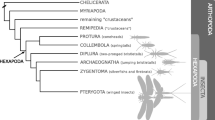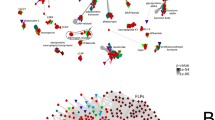Abstract
Dipteran arylphorin receptors, insect hexamerins, cheliceratan and crustacean hemocyanins, and crustacean and insect tyrosinases display significant sequence similarities. We have undertaken a systematic comparison of primary and secondary structures of these proteins. On the basis of multiple sequence alignments the phylogeny of these proteins was investigated. Hexamerin subunits, hemocyanin subunits, and tyrosinases share extensive similarities throughout the entire amino acid sequence. Our studies suggest the origin of arthropod hemocyanins from ancient tyrosinase-like proteins. Insect hexamerins likely evolved from hemocyanins of ancient crustaceans, supporting the proposed sister-group position of these subphyla. Arylphorin receptors, responsible for incorporation of hexamerins into the larval fat body of diptera, are related to hexamerins, hemocyanins, and tyrosinase. The receptor sequences display extensive similarities to the first and third domains of hemocyanins and hexamerins. In the middle region only limited amino acid conservation was observed. Elements important for hexamer formation are deleted in the receptors. Phylogenetic analysis indicated that dipteran arylphorin receptors diverged from ancient hexamerins, probably early in insect evolution.
Similar content being viewed by others
Abbreviations
- aa:
-
amino acid
- MYA:
-
million years ago; the other abbreviations are listed in Table 1
References
Ashida M, Yoshida H (1988) Limited proteolysis of prophenoloxidase during activation by microbial products in insect plasma and effect of phenoloxidase on electrophoresic mobility of plasma proteins. Insect Biochem 18:11–19
Aspan A, Huang TS, Cerenius L, Söderhäll K (1995) cDNA cloning of a prophenoloxidase from the freshwater crayfishPacifastacus leniusculus and its activation. Proc Natl Acad Sci USA 92:939–943
Aspan A, Söderhäll K (1991) Purification of prophenoloxidase from crayfish blood cells, and its activation by an endogenous serine proteinase. Insect Biochem 21:363–373
Bak HJ, Beintema JJ (1987)Panulirus interruptus hemocyanin. The elucidation of the complete amino acid sequence of subunit a. FEBS Lett 204:141–144
Beintema JJ, Stam WT, Hazes B, Smidt MP (1994) Evolution of arthropod hemocyanins and insect storage proteins (hexamerins). Mol Biol Evol 11:493–503
Bergström J (1979) Morphology of fossil arthropods as a guide to polyphyetic relationship. In: Gupta AP (ed) Arthropod phylogeny. Van Nordstrand Reinhold, New York, pp 33–56
Burmester T, Scheller K (1992) Identification of binding proteins involved in the stage-specific uptake of arylphorin by the fat body cells ofCalliphora vicina. Insect Biochem Mol Biol 22:211–220
Burmester T, Scheller K (1995a) Ecdysterone-mediated uptake of arylphorin by larval fat bodies ofCalliphora vicina: involvement and developmental regulation of arylphorin binding proteins. Insect Biochem Mol Biol 25:799–806
Burmester T, Scheller K (1995b) Complete cDNA-sequence of the receptor responsible for arylphorin uptake by the larval fat body of the blowfly,Calliphora vicina. Insect Biochem Mol Biol 25:981–989
Chung SO, Kubo T, Natori S (1995) Molecular cloning and sequencing of arylphorin-binding protein in protein granules ofSarcophaga fat body. J Biol Chem 270:4624–4631
Dayhoff MO (1979) Atlas of protein sequence and structure, vol 5, suppl 3. National Biomedical Research Foundation, Washington, DC
de Haas F, van Bruggen EFJ (1994) The interhexameric contacts in the four-hexameric hemocyanin from the tarantulaEurypelma californicum. J Mol Biol 237:464–478
de Kort CAD, Koopmanschap AB (1994) Nucleotide and deduced amino acid sequence of a cDNA clone encoding diapause protein 1, an arylphorin-type storage hexamer of the Colorado potato beetle. J Insect Physiol 40:527–535
Doolittle RF (1981) Similar amino acid sequences: chance or common ancestry? Science 214:149–159
Drexel R, Siegmund S, Schneider HJ, Linzen B, Gielens C, Lontie R, Kellermann J, Lottspeich F (1987) Complete sequence of a functional unit from a molluscan hemocyanin (Helix pomatia). Biol Chem Hoppe Seyler 368:617–635
Duhamel RC, Kunkel JG (1983) Cockroach larval-specific protein, a tyrosine-rich serum protein. J Biol Chem 258:14461–14465
Duhamel RC, Kunkel JG (1987) Moulting-cycle regulation of haemolymph protein clearance in cockroaches possible size-dependent mechanism. J Insect Physiol 33:155–158
Enderle U, Kduser G, Renn L, Scheller K, Koolman J (1983) Ecdysteroids in the hemolymph of blowfly are bound to calliphorin. In: Scheller K (ed) The larval serum proteins of insects: function, biosynthesis, genetic. Thieme, Stuttgart, pp 40–49
Felsenstein J (1985) Confidence limits on phylogenies: an approach using the bootstrap. Evolution 39:783–791
Felsenstein J (1993) PHYLIP: (phylogeny inference package) version 3.5c. Distributed by the author. Department of Genetics, University of Washington, Seattle
Fitch WM (1971) Toward defining the course of evolution: minimum change for a specified tree topology. System Zool 20:406–416
Fitch WM, Margoliash E (1967) Construction of phylogenetic trees. Science 155:279–284
Fujii T, Sakurai H, Izumi S, Tomino S (1989) Structure of the gene for the arylphorin-type storage protein SP2 ofBombyx mori. J Biol Chem 264:11020–11025
Gaykema WPJ, Hol WGJ, Vereijken JM, Soeter NM, Bak HL, Beintema JJ (1984) 3.2 Å structure of the copper-containing, oxygencarrying proteinPanulirus interruptus hemocyanin. Nature 309: 23–29
Hall M, Scott T, Sugumaran M, Söderhäll K, Law JH (1995) Prophenoloxidase of the hawkmothManduca sexta. Purification, activation, substrate specificity of the enzyme, and molecular cloning. EMBL accession No. L42556
Hennig W (1969) Stammesgeschichte der Insekten. W Kramer, Frankfurt
Jekel PA, Bak HL Soeter NM, Verejken JM, Beintema JJ (1988)Panulirus interruptus hemocyanin. The amino acid sequence of subunit b and anomalous behaviour of subunits a and b on polyacrylamide gel electrophoresis in the presence of SDS. Eur J Biochem 178: 403–412
Jones G, Brown N, Manczak M, Hiremath S, Kafatos FC (1990) Molecular cloning, regulation, and complete sequence of a hemocyanin-related, juvenile hormone-suppressible protein from insect hemolymph. J Biol Chem 25:8596–8602
Jones G, Manczak M, Horn M (1993) Hormonal regulation and properties of a new group of basic hemolymph proteins expressed during insect metamorphosis. J Biol Chem 268:1284–1291
Koopmanschap AB, Lammers JHM, de Kort CAD (1995) The structure of the gene encoding diapause protein 1 of the Colorado potato beetle (Leptinotarsa decemlineata). J Insect Physiol 41:509–518
Levenbook L, Bauer A (1984) The fate of the larval storage protein calliphorin during adult development ofCalliphora vicina. Insect Biochem 14:77–86
Linzen B, Soeter NM, Riggs AF, Schneider HJ, Schartau W, Moore MD, Behrens PQ, Nakashima H, Takagi T, Nemoto T, Vereijken JM, Bak HJ, Beintema JJ, Volbeda A, Gaykema WPJ, Hol WGJ (1985) The structure of arthropod hemocyanins. Science 229:519–524
Locke M, McDermind H, Brac T, Atkinson B (1982) Developmental changes in the synthesis of haemolymph polypeptides and their sequestration by the prepupal fat body ofCalpodes ethlius Stoll (Lepidoptera, Hesperiidae). Insect Biochem 12:431–440
Marinotti O, de Bianchi AG (1986) Uptake of storage protein byMusca fat body. J Insect Physiol 32:819–825
Markl J (1986) Evolution and function of structurally diverse subunits in the respiratory protein hemocyanin from arthropods. Biol Bull 171: 90–115
Markl J, Burmester T, Decker H, Sievel-Niemann A, Harris JR, Süling M, Naumann U, Scheller K (1992) Quaternary and subunit structure ofCalliphora arylphorin as deduced from electron microscopy, electrophoresis, and sequence similarities with arthropod hemocyanins. J Comp Physiol [B] 162:665–680
Markl J, Markl A, Schartau W, Linzen B (1979a) Subunit heterogeneity in arthropod hemocyanins: I. Chelicerata. J Comp Physiol 130: 283–292
Markl J, Hofer A, Bauer G, Markl A, Kemptner B, Brenzinger M, Linzen B (1979b) Subunit heterogeneity in arthropod hemocyanins: II. Crustacea. J Comp Physiol 133:67–175
Markl J, Winter S (1989)Subunit-specific monoclonal antibodies of tarantula hemocyanin, and a common epitope shared with calliphorin. J Comp Physiol [B] 159:139–151
Martin MD, Kinnear JF, Thomson JA (1971) Developmental changes in the late larvae ofCalliphora stygia: IV. Uptake of plasma protein by the fat body. Aust J Biol Sci 24:291–299
Maschat F, Dubertret ML, Therond P, Claverie JM, Lepesant JA (1990) Structure of the ecdysone-inducible P1 gene ofDrosophila melanogaster. J Mol Biol 214:359–372
Memmel NA, Trewitt PM, Grzelak K, Rajaratnam VS, Kumaran AK (1994) Nucleotide sequence, structure and developmental regulation of LHP82, a juvenile hormone-suppressible hexamerin gene from the waxmoth,Galleria mellonella. Insect Biochem Mol Biol 24:133–144
Memmel NA, Trewitt PM, Silhacek DL, Kumaran AK (1992) Nucleotide sequence and structure of the arylphorin gene fromGalleria mellonella. Insect Biochem Mol Biol 22:333–342
Miller S, Silhacek DL (1982) The synthesis and uptake of haemolymph storage proteins by the fat body of the greater wax moth,Galleria mellonella (L.). Insect Biochem 12:293–300
Müller G, Ruppert S, Schmid E, Schütz G (1988) Functional analysis of alternatively spliced tyrosinase gene transcripts. EMBO J 7: 2723–2730
Nakashima H, Behrens PQ, Moore MD, Yokota E, Riggs AF (1986) Structure of hemocyanin 11 from the horseshoe crab,Limulus polyphemus. J Biol Chem 261:10526–10533
Naumann U, Scheller K (1991) Complete cDNA and gene sequence of the developmentally regulated arylphorin ofCalliphora vicina and its relationship to insect haemolymph proteins and arthropod hemocyanins. Biochem Biophys Res Commun 177:963–972
Neuteboom B, Jekel PA, Beintema JJ (1992) Primary structure of hemocyanin subunit c fromPanulirus interruptus. Eur J Biochem 206:243–249
Pan MI, Telfer WH (1992) Selectivity in storage hexamerin clearing demonstrated with hemolymph transfusions betweenHyalophora cecropia andActias luna. Arch Insect Biochem Physiol 19:203–219
Peter MG, Scheller K (1991) Arylphorins and the integument. In: Retnakaran A, Binnington K (eds) The physiology of insect epidermis. CSIRO, East Melbourne, Australia, pp 115–124
Roberts DB, Brock HW (1981) The major serum proteins of diptera larvae. Experientia 37:103–110
Saitou N, Nei M (1987) The neighbor-joining method: a new method for reconstructing phylogenetic trees. Mol Biol Evol 4:406–425
Sakurai H, Tomoko F, Izumi S, Tomino S (1988) Complete nucleotide sequence of gene for sex-specific storage protein ofBombyx mori. Nucleic Acids Res 16:7717–7718
Schartau W, Eyerle F, Reisinger P, Geisert H, Storz H, Linzen B (1983) Hemocyanins in spiders, XIX. Complete amino-acid sequence of subunit d fromEurypelma californicum hemocyanin, and comparison with chain e. Hoppe-Seyler's Z Physiol Chem 364:1383–1409
Scheller K, Fischer B, Schenkel H (1990) Molecular properties, functions and developmentally regulated biosynthesis of arylphorin inCalliphora vicina. In: Hagedom HH, Hildebrand JG, Kidwell MG, Law JH (eds) Molecular insect science. Plenum Press, New York, pp 155–162
Sellos DY (1995) EMBL accession No. X82502
Telfer WH, Keim PS, Law JH (1983) Arylphorin, a new protein fromHyalophora ceuropia: comparison with calliphorin and manducin. Insect Biochem 13:601–613
Telfer WH, Kunkel JG (1991) The function and evolution of insect storage hexamers. Annu Rev Entomol 36:205–228
Turbeville JM, Pfeifer DM, Field KG, Raff RA (1991) The phylogenetic status of arthropods, as inferred from 18S rRNA sequences. Mol Biol Evol 8:669–686
Ueno K, Natori S (1982) Activation of fat body by 20-hydroxyecdysone for the selective incorporation of storage protein inSarcophaga peregrina larvae. Insect Biochem 12:185–191
Ueno K, Natori S (1984) Identification of storage protein receptor in the fat body membranes ofSarcophaga peregrina. J Biol Chem 259:12107–12111
Voit R, Feldmaier-Fuchs G (1990) Arthropod hemocyanins. Molecular cloning and sequencing of cDNAs encoding for tarantula hemocyanins subunits a and e. J Biol Chem 265:19447–19452
Volbeda A, Hol WGJ (1989) Crystal structure of hexameric hemocyanin fromPanulirus interruptus refined at 3.2 Å resolution. J Mol Biol 209:249–279
Wang XY, Frohlich DR, Wells MA (1993) Polymorphic cDNAs encode for the methionine-rich storage protein fromManduca sexta. EMBL accession No. L07609
Wang Z, Haunerland N (1994a) Receptor-mediated endocytosis of storage proteins by the fat body ofHelicoverpa zea. Cell Tissue Res 278:107–115
Wang Z, Haunerland N (1994b)Storage protein uptake inHelicoverpa zea: arylphorin and VHDL share a single receptor. Arch Insect Biochem Physiol 26:15–26
Willot E, Wang X-Y, Wells MA (1989) cDNA and gene sequence ofManduca sexta arylphorin, an aromatic amino acid-rich larval serum protein: homology to arthropod hemocyanins. J Biol Chem 264:19052–19059
Author information
Authors and Affiliations
Additional information
Correspondence to: T. Burmester
Rights and permissions
About this article
Cite this article
Burmester, T., Schellen, K. Common origin of arthropod tyrosinase, arthropod hemocyanin, insect hexamerin, and dipteran arylphorin receptor. J Mol Evol 42, 713–728 (1996). https://doi.org/10.1007/BF02338804
Received:
Accepted:
Issue Date:
DOI: https://doi.org/10.1007/BF02338804




